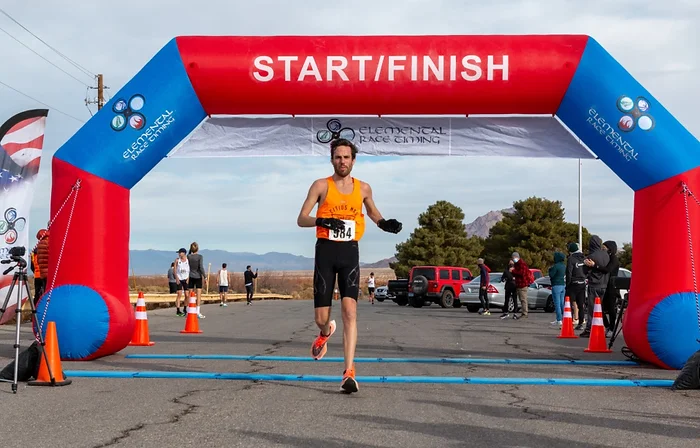How you handle the morning of your race is going to greatly impact how well you’re able to perform.
The most important thing to ensure you have a good race is to arrive at the location earlier than you think.
I like to get there two-ish hours before the race start. I know, I know, most people reading this just rolled their eyes. But I’m sticking with 2 hours and I’d settle for 90 minutes. Tons of people show up 30 minutes before the gun goes off, but they’re leaving a lot of performance on the table.
 First of all, we generally have to drive to events, sometimes far distances. Sitting in the car for long periods of time stretches out our high hamstrings and tightens our hip flexors. Hopping out of a car and then going to run a race is not ideal. Nor is it a good idea. Please don’t do that.
First of all, we generally have to drive to events, sometimes far distances. Sitting in the car for long periods of time stretches out our high hamstrings and tightens our hip flexors. Hopping out of a car and then going to run a race is not ideal. Nor is it a good idea. Please don’t do that.
Getting there early gives us time to walk around and stretch out from the road trip.
Pre-Race Fueling
So many people talk about carbo-loading days out from the race, but the most important carbohydrate loading we can do is the night before and morning of the race. Waking up earlier and getting to the race site earlier gives us more time to get in fuel.
So for breakfast, the timing is super individualized. Generally, 2-4 hours before race time is when people want to get that down, and it completely depends on how you digest. Then, if you feel like you want a little more calories, you can do that the last 30 minutes before the gun time with something really simple like a gel, a bar, a banana, etc.
There are many tried and true breakfast options available. Oatmeal, cereal, toast with peanut butter- You know the drill.

Okay now back to me talking about getting to the race earlier.
The most important thing getting to the venue early does, is it generally gives us unfettered access to the bathrooms!! Start that process early, because with about 30 minutes to go, lines will form for those race day porta-johns and you might not get to go!
I constantly hear race reports from folks having to wait 30 minutes or more to get that last-minute bathroom stop in. Even if we get there early that could still happen, but it’s a night and day difference from just needing to use the bathroom VS needing to while rushing to pin your bib to your shirt, get a last-minute drink, find your place in the corral or start line, change from your warmup shoes to race shoes, take off your warmup clothes, etc. etc., etc. Get there early enough to get those things handled way ahead of time.
Okay, I got to the venue super early like a crazy person, now what do I do? Grea! Thanks so much for asking. Well, first, go do any registration stuff you need to do. Pict questionk up your bib, check-in, get your T-shirt, etc. Then get your gear sorted out. Get your clothes sorted and ready. Make sure you have all the fuel and supplies you’re going to need. Use the bathroom. Go for a little walk to shake out the car ride. Use the bathroom again. Start visualizing how you’re going to approach the race. One more pit stop to pee. Check in with yourself on food and hydration. Do you need some more to eat or drink before the race starts? If this is a race that you’re carrying water or fuel, is all of that stuff mixed, prepared, and ready to go?
Warm-Up
Next let’s talk warmups. Depending on the race, warm ups and their start times will look really different. For 1-mile races up to 10k, we’re generally going to do 10-30 minutes of warmup, 45-60 minutes out from gun time. For a half marathon, we might do 5-15 minutes of light jogging.
For a full marathon and up, we might start phasing out the jogging warmup altogether. Marathons could be 0-10 minutes of jogging, and max 5 minutes for anything over that depending on how much you regularly run. If you aren’t a higher mileage athlete (you didn’t average over 35 mpw the last 6 months) then I wouldn’t jog, I’d go with some light mobility and flexibility drills and some walking.
I generally like to finish the jog at least 15-20 or more minutes before race time, sometimes more. This gives you tons of time to get in another bathroom stop or two and fix any issues that came up on the warmup. Are your shoes laced how you want them? Are you going to switch into racing shoes? Are you starting to feel a little hungry/thirsty? Is the weather different than you expected? You will also be able to feel out your body and have some time to stretch and mobilize anything that doesn’t feel fired up yet. Then you can do some walking stretches to make sure everything is ready to go; walking pulling heel to your butt, walking toe touches, knee-hugs towards your chest, leg swings, etc., whatever else you need to feel ready. This video is a good demonstration of some of those drills and mobilizations.
https://www.youtube.com/watch?v=uOes02EQtYQ
SUPER MEGA PRO TIP: When the bathrooms do have crazy wait times, us sneaky experienced runners will use our warmup to jog to another bathroom, maybe there’s a public bathroom a half mile away, or we could jog out into the woods, and handle business that way as well.
Once we get into the corral or staging area we still have time to work on a few things. Try to sort yourself in the corral by where you think you’ll finish in the race, but be aggressive here. People will often just line up at the front for no reason so don’t be scared to be further forward than you think.n
![Looks like I'm still eating as the gun goes off =]](https://runbaldwin.com/wp-content/uploads/2024/01/0e9b64_6ab0c00519c74f88bd0c88b2c79ad35emv2-300x186.webp)
I try to convince every athlete to bring 2 extra gels with them to have before the race if they want them. A bar or piece of fruit also works great, they’re just harder to get rid of/stash. Often with pre-race nerves, we go to the start line slightly under-fueled. Don’t be scared to get some extra carbs in before the gun goes off to ensure your carbohydrate stores are at optimal levels. I’ll also bring a plastic water bottle with liquid carbs and electrolytes to the start line if it’s a race where I’m not carrying my own water. Usually, I can toss it to my wife or a friend right before the gun goes off.
Alright, the gun has gone off – now what?
Pacing
Every world record from 1500 meters to the marathon has been set running negative splits – running the first half of the race slightly slower than the second half. Also known as not going out too fast. If you’ve been coached by me for a while you’ve heard me say this MANY times, but the worst thing we can do at a race is to go out too fast. We can easily make up for a slow first mile, but sometimes we can’t bounce back from going out too hard. Why? It spikes our heart rate and pushes us into too high of a threshold zone. In a race setting, it’s extremely difficult to reverse that. Start out easy.
All that is left is to have a good time. It’s easy to forget that part. Being able to train and participate in events is a gift. We are so lucky to get to do it. It’s a privilege to get nervous. It’s an incredible opportunity to push your body in a race. Remember that and enjoy it. When you get done, try to write some thoughts down on what might help you for the next event. Have fun and Good Luck my friends.
Quick note: Make sure to check out my article on approaching workouts. The principles that make a great workout also translate to a successful race. Start integrating those effective habits into your routine months before the next race for optimal results. Cheers!



